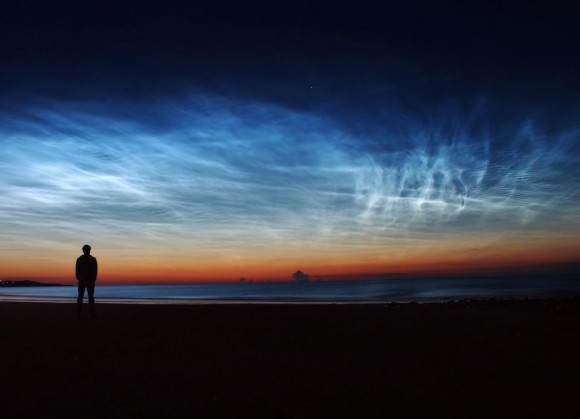
Spaceweather.com is reporting an early-season display of noctilucent clouds above Antarctica. These clouds are seasonal, and the season for Earth’s southerly latitudes typically comes a bit later than this. Data from the AIM spacecraft – whose purpose is the study of these clouds – shows that this 2016 season began as early as November 17. Spaceweather.com explained:
This just in from NASA’s AIM spacecraft: The sky above Antarctica is glowing electric blue. A ring of bright noctilucent clouds (NLCs) has formed around the South Pole, shown here in a November 24 image taken by [AIM]’s Cloud Imaging and Particle Size (CIPS) Instrument.
NLCs are Earth’s highest clouds. They form more than 80 km [60 miles] above Earth’s surface. Indeed, they are a mixture of Earth and space. Wisps of summertime water vapor rising from the planet below wrap themselves around meteoroids, forming tiny crystals of ice. Emphasis on summertime; NLCs appear on the eve of summer in both hemispheres.
Why do we see these clouds shining in the the night sky? Simply because they are so high up; the sun continues shining on them even after it has set on our part of Earth.
Cora Randall, a member of the AIM science team at the University of Colorado, said:
This season … is tied with 2013 for the earliest Southern Hemisphere season in the CIPS data record. This was not at all a surprise: The Southern Hemisphere polar stratospheric winds switched to their summer-like state quite early this year.
Read more: The secrets of night-shining clouds
By the way, we at EarthSky see many more photos of noctilucent clouds from northerly latitudes than southerly latitudes, because more EarthSky community members (and more people generally) live at those latitudes. Matt Robinson captured the image below. He saw this grand display of electric-blue noctilucent clouds in July 2014, over Sunderland, UK.

Bottom line: November 24, 2016 image from the AIM spacecraft showing noctilucent, or night-shining, clouds over Antarctica.











